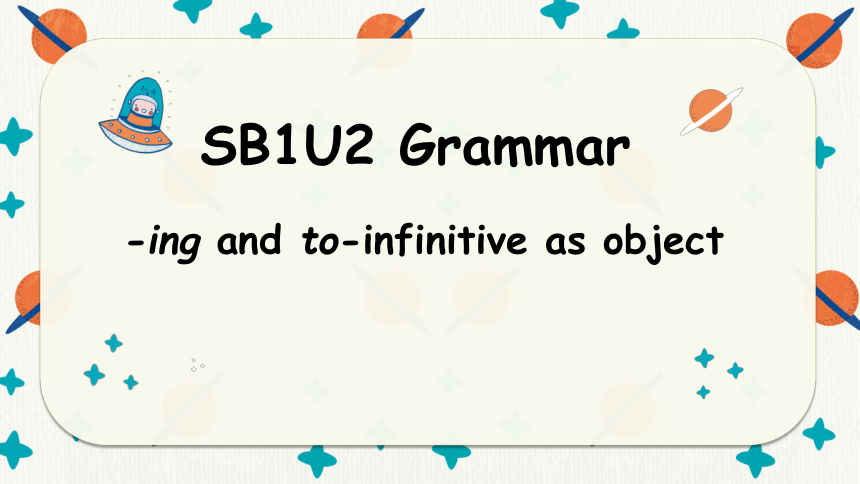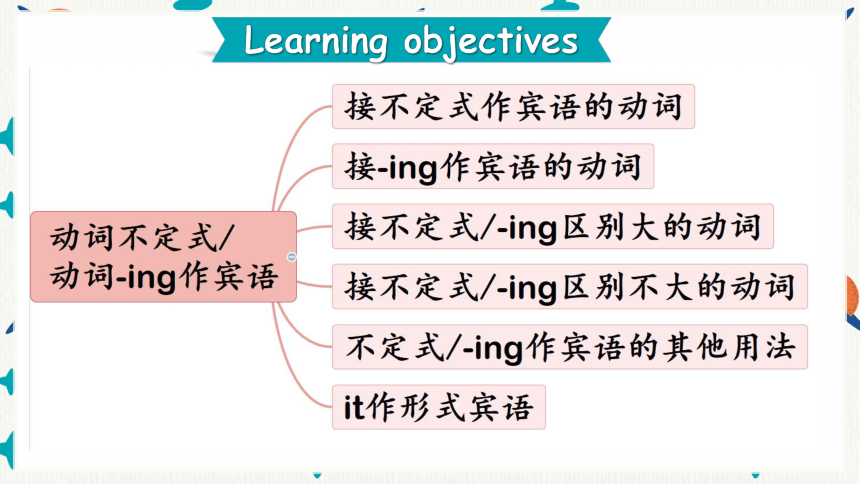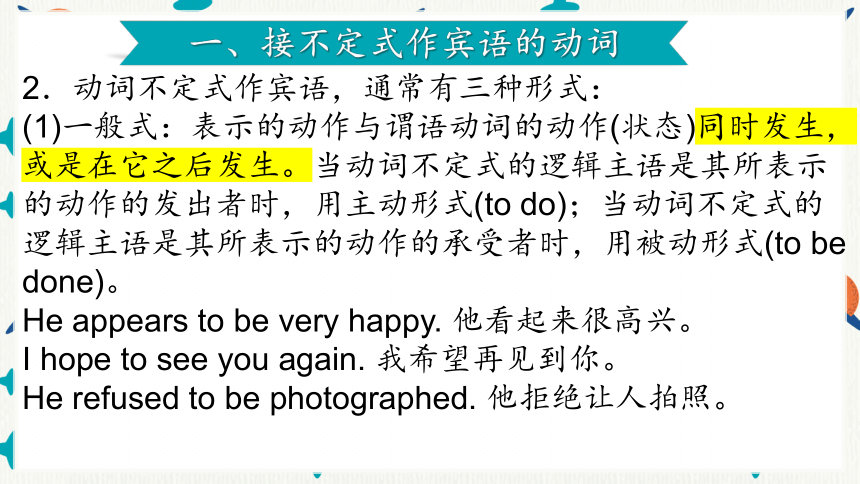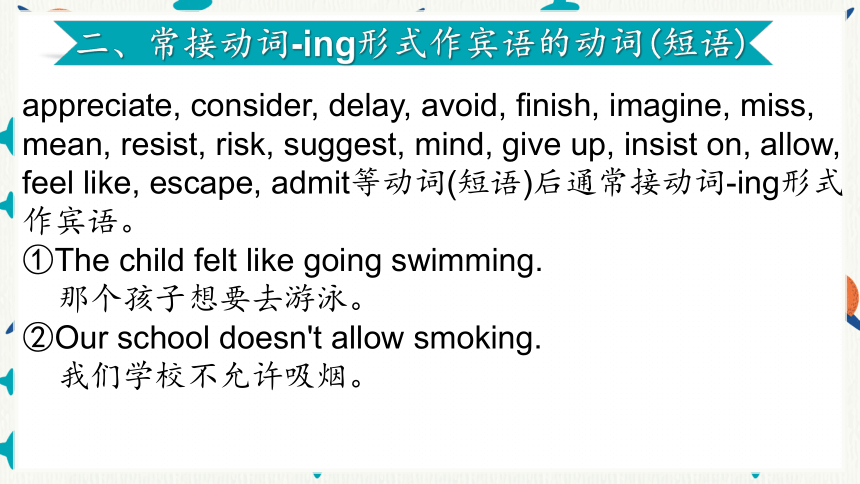外研版(2019) 选择性必修第一册 Unit 2 Onwards and Upwards Grammar 课件-(17张PPT)
文档属性
| 名称 | 外研版(2019) 选择性必修第一册 Unit 2 Onwards and Upwards Grammar 课件-(17张PPT) |  | |
| 格式 | pptx | ||
| 文件大小 | 5.2MB | ||
| 资源类型 | 教案 | ||
| 版本资源 | 外研版(2019) | ||
| 科目 | 英语 | ||
| 更新时间 | 2022-10-20 19:24:54 | ||
图片预览







文档简介
(共17张PPT)
SB1U2 Grammar
-ing and to-infinitive as object
Learning objectives
一、接不定式作宾语的动词
1.常接动词不定式作宾语的动词:
agree, afford, offer, intend, plan, demand, promise, help, prepare, decide, refuse, choose, fail, pretend, wish/hope/want/expect, manage, determine, beg, arrange, threaten, claim, aim, hesitate, seem, happen
①I plan to finish the novel. 我计划完成那部小说。
(to finish the novel在句中作宾语)
②He pretended to be sleeping when I came in.
我进去的时候,他假装在睡觉。
(to be sleeping在句中作宾语)
一、接不定式作宾语的动词
2.动词不定式作宾语,通常有三种形式:
(1)一般式:表示的动作与谓语动词的动作(状态)同时发生,或是在它之后发生。当动词不定式的逻辑主语是其所表示的动作的发出者时,用主动形式(to do);当动词不定式的逻辑主语是其所表示的动作的承受者时,用被动形式(to be done)。
He appears to be very happy. 他看起来很高兴。
I hope to see you again. 我希望再见到你。
He refused to be photographed. 他拒绝让人拍照。
一、接不定式作宾语的动词
(2)进行式(to be doing):动词不定式所表示的动作与谓语动词所表示的动作同时发生,并强调动作的持续性或动作正在进行。
It happened to be raining when I got there.
我到达那里的时候,碰巧在下雨。
(3)完成式(to have done):动词不定式所表示的动作发生在谓语动词所表示的动作之前。
He seems to have cut off the water supply.
=It seems that he has cut off the water supply.
他好像已切断了供水。
二、常接动词 ing形式作宾语的动词(短语)
appreciate, consider, delay, avoid, finish, imagine, miss, mean, resist, risk, suggest, mind, give up, insist on, allow, feel like, escape, admit等动词(短语)后通常接动词 ing形式作宾语。
①The child felt like going swimming.
那个孩子想要去游泳。
②Our school doesn't allow smoking.
我们学校不允许吸烟。
动词 ing的复合结构作宾语,其形式有以下几种:
形容词性物主代词+动词-ing
人称代词宾格+动词-ing
名词’s+动词-ing
名词 +动词-ing
Attention
He left the city without our knowing it.他离开这座城市,我们都不知道。Would you mind my/me using your cell phone 你介意我用你的手机吗?I knew nothing about the window being open. 我一点儿也不知道窗户开着。
三、接不定式/ ing区别大的词
四、接不定式/ ing区别大的词
1.表示 “爱憎喜恶”的情感类动词
hate, love, like等动词后接动词不定式和动词 ing形式作宾语时,含义有些区别:
接动词不定式作宾语时,一般表示一次性、具体的动作;
接动词 ing形式作宾语时,一般表示习惯性、一般性的动作。
I like reading, but I don't like to read today.
我喜欢读书,但今天不想读。
2.begin, start, continue等少数几个动词后接动词不定式或动词 ing形式作宾语时意义差别不大。
Tom began learning/to learn how to use a computer.
汤姆开始学习如何使用电脑。
Attention
动词begin, continue, start等后接不定式和动词 ing形式一般情况下可以互换,但是在下面的情况下,这些动词后只能接to do。
(1)当begin, continue, start等本身用于进行时的时候。
The students are starting to work on the maths problems. 学生们开始做数学题。
(2)当begin, continue, start等与know, understand等表示心理状态的动词连用时。
I began to understand what had happened. 我开始明白发生了什么。
五、不定式/ ing作宾语的其他用法
在need, require, want(表“需要”)等动词的后面可接动词 ing形式作宾语(用主动形式表示被动含义),也可接动词不定式的被动式作宾语。
My shirt needs washing.
=My shirt needs to be washed.
我的衬衫该洗了。
六、it作形式宾语
记住句型“6123”结构:
“6”指主句中常用的动词:think,believe,make, find, consider,feel;
“1”指的是形式宾语 it;
“2”指的是宾补的两种形式:形容词或名词;
“3”指的是真正宾语的三种形式:不定式短语,动名词短语或that引导的宾语从句。
此结构中,it是形式宾语,其后的adj.或n.是宾语补足语,而动名词/不定式/宾语从句才是真正的宾语。
vt.+it+宾补(no use/no good/useless/a waste of time)
+doing...
①I think it no use discussing the matter again.
我认为再讨论此事没有用处了。
②Do you consider it any good trying again
你觉得再试一下会有好处吗
vt. + it + adj./n. + (for sb. /sth.) + 真正的宾语
(vt: think/ believe/ suppose/ consider/ feel/ make/ find)
doing sth. / to do sth./that从句
vt.+it+宾补(adj./n.)+(for sb.) to do.../宾语从句
She has made it a rule to go out for a walk after supper. 她养成了晚饭后出去散步的习惯。
I feel it pleasant to work with you. 我觉得与你共事是件令人愉快的事。
I must make it clear that I'll always support you.我必须说清楚我会一直支持你。
Practice
With WeChat becoming more and more popular in China, we seem _______________ (lose) the art of communicating face to face now.
After he finished _________ (do) maths homework, he went on ______________ (write) a composition.
I regret ________ (tell) you that you are not invited to the meeting.
I require him ____________ the trees, because they require __________________________________ in this hot weather. (water)
to be losing
doing
to write
to tell
to water
watering/ to be watered
Practice
I feel it my honor ____________ (make) friends with you.
I think it no use ___________ (argue) over the matter with him again.
We think it necessary ______ we read English aloud every day.
to make
arguing
that
Thank you!
SB1U2 Grammar
-ing and to-infinitive as object
Learning objectives
一、接不定式作宾语的动词
1.常接动词不定式作宾语的动词:
agree, afford, offer, intend, plan, demand, promise, help, prepare, decide, refuse, choose, fail, pretend, wish/hope/want/expect, manage, determine, beg, arrange, threaten, claim, aim, hesitate, seem, happen
①I plan to finish the novel. 我计划完成那部小说。
(to finish the novel在句中作宾语)
②He pretended to be sleeping when I came in.
我进去的时候,他假装在睡觉。
(to be sleeping在句中作宾语)
一、接不定式作宾语的动词
2.动词不定式作宾语,通常有三种形式:
(1)一般式:表示的动作与谓语动词的动作(状态)同时发生,或是在它之后发生。当动词不定式的逻辑主语是其所表示的动作的发出者时,用主动形式(to do);当动词不定式的逻辑主语是其所表示的动作的承受者时,用被动形式(to be done)。
He appears to be very happy. 他看起来很高兴。
I hope to see you again. 我希望再见到你。
He refused to be photographed. 他拒绝让人拍照。
一、接不定式作宾语的动词
(2)进行式(to be doing):动词不定式所表示的动作与谓语动词所表示的动作同时发生,并强调动作的持续性或动作正在进行。
It happened to be raining when I got there.
我到达那里的时候,碰巧在下雨。
(3)完成式(to have done):动词不定式所表示的动作发生在谓语动词所表示的动作之前。
He seems to have cut off the water supply.
=It seems that he has cut off the water supply.
他好像已切断了供水。
二、常接动词 ing形式作宾语的动词(短语)
appreciate, consider, delay, avoid, finish, imagine, miss, mean, resist, risk, suggest, mind, give up, insist on, allow, feel like, escape, admit等动词(短语)后通常接动词 ing形式作宾语。
①The child felt like going swimming.
那个孩子想要去游泳。
②Our school doesn't allow smoking.
我们学校不允许吸烟。
动词 ing的复合结构作宾语,其形式有以下几种:
形容词性物主代词+动词-ing
人称代词宾格+动词-ing
名词’s+动词-ing
名词 +动词-ing
Attention
He left the city without our knowing it.他离开这座城市,我们都不知道。Would you mind my/me using your cell phone 你介意我用你的手机吗?I knew nothing about the window being open. 我一点儿也不知道窗户开着。
三、接不定式/ ing区别大的词
四、接不定式/ ing区别大的词
1.表示 “爱憎喜恶”的情感类动词
hate, love, like等动词后接动词不定式和动词 ing形式作宾语时,含义有些区别:
接动词不定式作宾语时,一般表示一次性、具体的动作;
接动词 ing形式作宾语时,一般表示习惯性、一般性的动作。
I like reading, but I don't like to read today.
我喜欢读书,但今天不想读。
2.begin, start, continue等少数几个动词后接动词不定式或动词 ing形式作宾语时意义差别不大。
Tom began learning/to learn how to use a computer.
汤姆开始学习如何使用电脑。
Attention
动词begin, continue, start等后接不定式和动词 ing形式一般情况下可以互换,但是在下面的情况下,这些动词后只能接to do。
(1)当begin, continue, start等本身用于进行时的时候。
The students are starting to work on the maths problems. 学生们开始做数学题。
(2)当begin, continue, start等与know, understand等表示心理状态的动词连用时。
I began to understand what had happened. 我开始明白发生了什么。
五、不定式/ ing作宾语的其他用法
在need, require, want(表“需要”)等动词的后面可接动词 ing形式作宾语(用主动形式表示被动含义),也可接动词不定式的被动式作宾语。
My shirt needs washing.
=My shirt needs to be washed.
我的衬衫该洗了。
六、it作形式宾语
记住句型“6123”结构:
“6”指主句中常用的动词:think,believe,make, find, consider,feel;
“1”指的是形式宾语 it;
“2”指的是宾补的两种形式:形容词或名词;
“3”指的是真正宾语的三种形式:不定式短语,动名词短语或that引导的宾语从句。
此结构中,it是形式宾语,其后的adj.或n.是宾语补足语,而动名词/不定式/宾语从句才是真正的宾语。
vt.+it+宾补(no use/no good/useless/a waste of time)
+doing...
①I think it no use discussing the matter again.
我认为再讨论此事没有用处了。
②Do you consider it any good trying again
你觉得再试一下会有好处吗
vt. + it + adj./n. + (for sb. /sth.) + 真正的宾语
(vt: think/ believe/ suppose/ consider/ feel/ make/ find)
doing sth. / to do sth./that从句
vt.+it+宾补(adj./n.)+(for sb.) to do.../宾语从句
She has made it a rule to go out for a walk after supper. 她养成了晚饭后出去散步的习惯。
I feel it pleasant to work with you. 我觉得与你共事是件令人愉快的事。
I must make it clear that I'll always support you.我必须说清楚我会一直支持你。
Practice
With WeChat becoming more and more popular in China, we seem _______________ (lose) the art of communicating face to face now.
After he finished _________ (do) maths homework, he went on ______________ (write) a composition.
I regret ________ (tell) you that you are not invited to the meeting.
I require him ____________ the trees, because they require __________________________________ in this hot weather. (water)
to be losing
doing
to write
to tell
to water
watering/ to be watered
Practice
I feel it my honor ____________ (make) friends with you.
I think it no use ___________ (argue) over the matter with him again.
We think it necessary ______ we read English aloud every day.
to make
arguing
that
Thank you!
